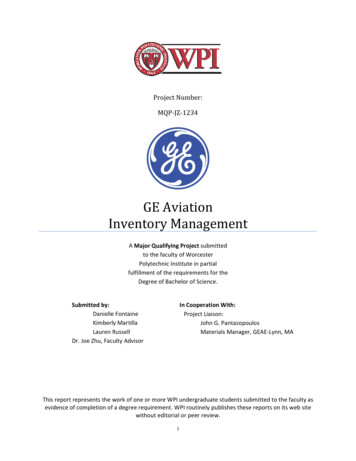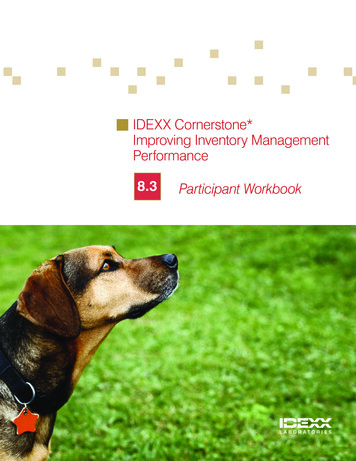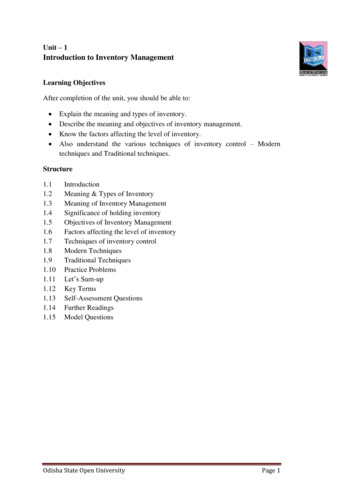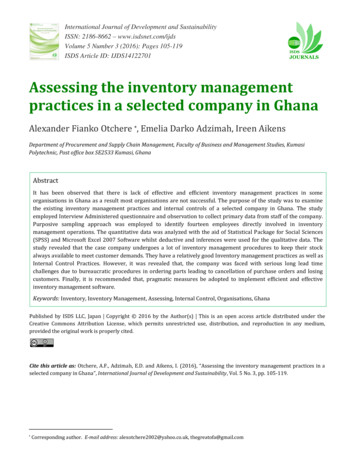
Transcription
Project Number:MQP‐JZ‐1234GE AviationInventory ManagementA Major Qualifying Project submittedto the faculty of WorcesterPolytechnic Institute in partialfulfillment of the requirements for theDegree of Bachelor of Science.Submitted by:Danielle FontaineKimberly MartillaLauren RussellDr. Joe Zhu, Faculty AdvisorIn Cooperation With:Project Liaison:John G. PantazopoulosMaterials Manager, GEAE‐Lynn, MAThis report represents the work of one or more WPI undergraduate students submitted to the faculty asevidence of completion of a degree requirement. WPI routinely publishes these reports on its web sitewithout editorial or peer review.i
AbstractOur GE Aviation Inventory Management project tasked us to create an inventory ‘faceplate’ toolthat is user friendly and enables GE’s LMO team to quickly identify and react to material inputschedules. The tool utilizes raw and work in progress (WIP) balances linked to cycle times andinput schedules and suggests correct input material to fulfill customer schedules while drivinginventory balances down.ii
AcknowledgementsWe would like to thank everyone in the LMO team at GE Aviation in Lynn, MA, especially oursponsor John Pantazopoulos for all of his help and insight. We would also like to thank ourAdvisor Dr. Joe Zhu.iii
Authorship PageDanielle Fontaine, Kimberly Martilla, and Lauren Russellcontributed equally to the creation of this report.iv
Table of ContentsAbstract . iiAcknowledgements . iiiAuthorship Page . ivTable of Contents . vList of Figures .viiList of Tables.viiiExecutive Summary .ixBackground Research . xMethodology . xResults . xiConclusions and Recommendations . xiiChapter 1: Introduction into Inventory Management . 1Chapter 2: Background . 32.1 What is Inventory Management? . 32.2 Types of Inventory Management Systems . 52.3 GE‐ Aviation . 13Chapter 3: Methodology. 163.1 Assess Current GE Aviation Inventory Management Practices. 173.2 Create a Tool to Help Production Specialists, According to Their Needs . 183.2.1 Development and ‘Prototypes’ . 183.2.2 Interviewing . 193.2.3 Editing the Tool According to Specialist Feedback . 193.3 Aid GE Aviation in future development and automation of our production tool. . 21Chapter 4: Results and Analysis . 224.1 Production Planning Tool: Process Mapping . 224.1.1 Column 1: Ship Level . 224.1.2 Column 2: Bill of Materials (BOM) . 244.1.3 Column 3: Type . 254.1.4 Column 4: Quantity per Engine (QPE) . 264.1.5 Column 7: Unit Cost . 274.1.6 Columns 8‐17: Schedule/Promise . 274.2 Step‐by‐Step Recipe Book: How to Make the Production Faceplate . 28v
4.2.1 Column 1: Ship Level . 284.2.2 Column 2: Bill of Materials (BOM) . 324.2.3 Column 3: Type . 334.2.4 Column 4: Quantity per Engine (QPE) . 344.2.5 Column 5: O/H Raw (On‐Hand Raw Material) . 354.2.6 Column 6: In WIP . 364.2.7 Column 7: Unit Cost . 364.2.8 Columns 8‐17: Schedule/Promise . 374.2.9 Columns 18‐19: Need/Action Box . 39Chapter 5: Conclusions and Recommendations . 415.1 Recommendations for Further Improvement of the Faceplate . 415.2 Recommendations for Future Improvement of the Business . 42Appendix A: Works Cited . 44vi
List of FiguresFigure 1: Final Design of Our Production Planning Faceplate . xiFigure 2: Simple Example of a Bill of Materials. 4Figure 3: The Economic Order Quantity . 7Figure 4: Simple Deterministic Inventory Model Based on Fixed Demand Lead Time . 7Figure 5: Map of Vendor Managed Inventory System . 9Figure 6: Flow of Orders and Goods in a VMI System .10Figure 7: Graphical Representation of ABC Method .11Figure 8: Flow of a MRP system .12Figure 9: The Basic Structure of a GE Engine .14Figure 10: Methodology Flowchart Illustrating the Goals and Process of Our Project.17Figure 11: Breakdown of the Cumulative Cycle Time for a Part .23vii
List of TablesTable 1: Example of the HIRSS part spreadsheet .18Table 2: Our "Faceplate" tool for Part 2110M69G06 .20Table 3: Highlighted is the 'Quick Look Need for Action' Section for Production Specialists .21Table 4: Production Planning Faceplate, Column 1 .22Table 5: Line with Part 2110M69G06 within the sox76 LMO 201009 Report. .24Table 6: Production Planning Tool, Column 2: BOM .24Table 7: Production Planning Tool, Column 3: Type .25Table 8: Production Planning Tool, Column 4: QPE.26Table 9: Production Planning Tool, Column 7: Unit Cost .27Table 10: Production Planning Tool, Columns 8‐17: Schedule to Promise .27Table 11: Top Parts for BOM Part Number Column .29Table 12: Production Planning Faceplate, Column 1, Row 1 .29Table 13: Top Parts for BOM Program Column .29Table 14: Production Planning Faceplate, Column 1, Row 2 .30Table 15: Top Parts for BOM Description Column .30Table 16: Production Planning Faceplate, Column 1, Row 3 .30Table 17: Production Planning Faceplate, Column 1, Row 4 .31Table 18: sox76 LMO 201009 Total Cost Column .31Table 19: sox76 LMO 201009 Measured Part Number and “totals” Column.32Table 20: Production Planning Faceplate, Column 1, Row 5 .32Table 21: sox76 LMO 201009 Bill of Materials Column .33Table 22: Production Planning Faceplate, Column 2 .33Table 23: sox76 LMO 201009 Make or Buy Column .33Table 24: Production Planning Faceplate, Column 3 .34Table 25: Sept YTD SDC Input, Type C or 2 Bin Column .34Table 26: sox76 LMO 201009 QPA Column. 35Table 27: Production Planning Faceplate, Column 4 .35Table 28: Production Planning Faceplate, Column 5 .36Table 29: Production Planning Faceplate, Column 6 .36Table 30: sox76 LMO 201009, Current Unit Cost Column.37Table 31: Production Planning Faceplate, Column 7 .37Table 32: Production Planning Faceplate, Column 8, Row 1 .37Table 33: Production Planning Faceplate, Columns 8‐17 .38Table 34: Production Planning Faceplate, Column 8, Row 2 .38Table 35: SMIR Report, Sum of Quantity Row .39Table 36: Production Planning Faceplate, Column 8, Row 3 .39Table 37: Production Planning Faceplate, Need Column.39Table 38: Production Planning Faceplate, Action Column .40viii
Executive SummaryInventory is the total amount of goods a business has on hand at a given time. It is a vital assetthat keeps that business running smoothly, but too large amounts of inventory can lead toexorbitant cost levels. In manufacturing, a substantial amount of raw material inventory must beavailable to ensure production stays on time. This is why manufacturing companies implementinventory management systems; to control inventory levels to where demand can still be met andcosts related to inventory can be minimized. Specifically in the engine manufacturing industry,inventory management is especially important because the costs of the parts being manufacturingcan reach upwards of a million dollars. Furthermore, because parts are so large, storing inventoryrequires additional hefty costs.General Electric (GE) Aviation’s manufacturing plant in Lynn, MA has a large infrastructure inplace to deal with inventory management. An important facet of GE’s inventory managementsystem is production planning. This involves meeting weekly demand and gauging how muchraw material will be needed, how much is already within the system, and how much needs to beordered. Previously, production specialists used multiple and sometimes contradictory orconfusing databases, data gathered from machine operators, and past experience to gauge whatwas needed to meet production goals. Our Major Qualifying Project proposed to reduce theconfusion of this process by creating a Production Planning Faceplate. This tool gaveproduction specialists one quick glance source to find all the information they would need tomake production decisions. By combining cost, business type, WIP levels, and schedulinginformation for ship level parts and their bill of material components into one tool, allinformation needed for production specialists and managers in each business to make decisionsis easily accessed in one place. Future automation of our faceplate tool will enable it to beupdated Monday mornings so specialists can have the most up to date information at theirfingertips. The faceplate tool has the promise to increase inventory turnover ratios in the comingyear and reduce inventory and cost levels.ix
Background ResearchInventory Management is important for all manufacturing industries to implement, but morespecifically it is important for different industries to implement the type of inventorymanagement system that best fits their needs. There are eight main types of inventorymanagement systems; although there are many custom alterations made to these basic typesmade by companies to best fit their needs. The eight main types of inventory managementsystems are the perpetual system, Just in Time (JIT), Economic Order Quantity based system(EOQ), Safety Stock based system (SS), Last In First Out (LIFO) or First In First Out (FIFO),Vendor Managed Inventory (VMI), the ABC Method, and finally Material RequirementsPlanning (MRP). MRP is a computerized ordering and scheduling system that uses datagenerated from the company, like the Bill of Materials, to project what material will be needed inthe future. The system keeps track of the parts that production is dependent on and analyzes it toperfect the production schedules. GE Aviation’s plant in Lynn most closely follows a MaterialRequirements Planning system, where it predicts the demand and scheduling week to week, andsets goals for production in each business within the plant. Though MRP is not the ideal systemto keep inventory levels low (JIT production would hold this title) it works best for GE Aviationbecause the production of turbine engines takes time production must begin before demand isplaced. Therefore demand must be predicted using expertise, and past demand data. Using theinformation gained through our background research we were able to understand what theproduction tool was needed to accomplish.MethodologyAfter using our background research to understand GE Aviation’s inventory managementpractices, our project was aimed to assist the Lynn plant in improving their inventorymanagement system and assisting the production specialists with meeting their weekly,quarterly, and yearly production goals. With this in mind, we developed three main objectives toaccomplish our goal.The first objective was to assess current GE Aviation inventory management practices. Ourpreliminary background research was broken into three main areas; defining inventorymanagement, the main types of systems, and a background look into GE Aviations products andpractice.x
The second objective was to create a tool to help product specialists according to their needs.The goal of our tool was to aid specialists to make easier production-scheduling decisions bybringing together all the information they need into one easily accessible tool. To reach oursecond objective, we created prototypes of our faceplate tool, and then interviewed theproduction specialists and business leaders of each of the eleven businesses within the Lynnplant for feedback as to what they liked about the faceplate and what they thought it was missing.We then finalized the design of the tool by using the interviewing feedback to make the additionsthought necessary.Our third and final project objective was to aid GE Aviation in future development andautomation of our production tool. In order to ensure the continued use of our faceplate as asustainable and standardized tool, automation was necessary but unfortunately out of the scopeof our project. We therefore created a process map and step-by-step recipe book to aid any futureprojects into creating an automated system.ResultsOur three main results were the production planning faceplate tool itself, the process map, whichgive and in depth look at the tool and its components, and the recipe book, which gives step-bystep instructions how and where all the data in the faceplate is to be collected.After the interviewing process, we created the final faceplate design, seen below in Figure 1.Figure 1: Final Design of Our Production Planning FaceplateThe tool starts off by displaying the Ship level part searched for, what engine it is used in, adescription of the part, its cycle, and cost (column 1). It then breaks down into all the Bill ofMaterial parts necessary for that part, what type of BOM part it is, the quantity per engine, howmuch on hand raw material GE has on hand, the material in WIP, and the unit cost of each BOMxi
part. The next section of the tool is the Schedule/ Promise production planning levels for the shiplevel part and its components. The schedule section is the number of parts GE plans tomanufacture for the week. The promise schedule takes into account demand and is what GE hastold its customers it will ship out for that week. The last section is the Need/Action block. Thisgives the production specialist a quick glance, according to the given data what actions they needto take, such as “order more of part X from vendor Y”.Conclusions and RecommendationsThe production planning tool has the potential to greatly improve the efficiency of production atGE Aviation in Lynn. By creating a faceplate tool for business leaders and productionsspecialists where all necessary information can be accessed, all confusion between managementsgoals for production and the complexity of data and how to get the data needed to meet thesegoals can be eliminated.For future sustainability, we have also recommended improvements that can be made to thefaceplate as well as the business to continue to develop GE Aviation in Lynn. For thedevelopment of the faceplate, we suggested adding a filter to the database that sorts partsaccording to the business unit for quick reference for each business unit’s production specialist.We also suggest adding a column for vendor code for each BOM part. This would make it easyfor the reordering of parts because vendor information would already be visible. We also suggestin addition to the WIP column, to add a “nonconforming (NC) parts” column that gives theamount of nonconforming parts in WIP throughout the factory. Currently, there is no easy way toaccess this information and it is important to know if 90% of what you think is WIP you can usein the week’s production is actually unusable. Our last suggested for the development of thefaceplate is to sort BOM parts by level of need action, instead of numerical/alphabetical.In addition to recommendations for the faceplate, we have made suggestions for furtherimprovements of production not relating to the faceplate. We suggested implementing aContinuous Improvements Manager within the plant to be in charge of Lean Six Sigma practices,and sustaining 5S initiatives to keep the plant as safe as possible. After learning about the currentproblems the Lynn plant has with nonconforming parts, we recommended a Red Tag System thatwill store nonconforming parts both electronic as well as designating a place within the plant tohold the parts. This will give the faceplate an easy place to access information on nonconformingparts and keep the parts from cluttering the work stations throughout the plant. Finally, wexii
suggest the evaluation of vendors in order to reduce the number of vendors when necessary andadd vendors to other areas if also necessary. By implementing the production planning faceplatetool, and taking into consideration our suggestions for further growth, GE Aviation’s productionspecialists will be able to greatly improve the yearly inventory turnover ratio, and meetproduction cost goals.xiii
Chapter 1: Introduction into Inventory ManagementInventory is the total amount of goods a business has on hand at a given time. It is an imperativeasset that keeps that business running smoothly in many ways. First, inventory helps thecompany meet demand. Customers want products in the shortest amount of time available, andcompanies often satisfy this demand by keeping final goods inventory on hand.1 Though this isgood customer satisfaction, if too much final goods inventory is kept they can become outdatedand therefore never sell. Businesses within industries where the demand is erratic must play abalancing act to get the amount of inventory at the needed levels. Inventory is also important tokeep operations running smoothly. In manufacturing, a substantial amount of raw materialinventory must be available to ensure production stays on time. In many instances, companiesalso opt to keep inventory between processes within the manufacturing of a product atdecoupling points in order to reduce lead times and reduces the dependency of operations withinthe plant. This type of inventory is known as WIP, which stands for work in progress. Though itis good to have a designated amount of WIP in between some processes, the unsanctionedbuildup of WIP can be an indicator of a production flaw such as a bottleneck. Inventory alsohelps to reduce the lead-time of placing an order, to when the product reaches the customer; thelonger the lead-time, the more inventory a firm must keep on hand. Next, inventory can be usedas a buffer for hedging, a customer buying in bulk for a number of reasons, and for when thecompany decides to buy raw materials in bulk at a discounted price. For both these instances, themoney the firm will gain (hedging) or save (buying raw materials in bulk) is greater than the costof holding excess inventory.2 Yet despite all this, inventory also represents cash that is tied upand unavailable to the company as well as costs in storage and taxes, and excess inventory can beholding up millions of a company’s money. Therefore the company must control and manage itsinventory levels at the optimal level.GE Aviation is one of the three businesses that make up the Technology Infrastructure branch ofGE, along with healthcare and transportation.3 Within GE Aviation, there are 7 worldwideplants. The plant at Lynn, MA is then broken up into 11 business units. Due to the nature andcost of the product GE Aviation in Lynn produces, any amount of inventory can cause the plant1Encyclopedia, Reference For Business. (2011). Inventory ManagementIbid.3General Electric. (2011). GE Aviation Factsheet.21
to not meet its goals for production and profit. It is the 11 business units in Lynn (explained indetail in Chapter 2) that this project aims to aid in improving production, and reducing turnoverratios, cycle times and inventory levels.2
Chapter 2: Background2.1 What is Inventory Management?Inventory Management, also called Inventory control, is a company’s efforts to comprehend theminimal cost and levels of inventory held in which they can still meet demand. Many balancingacts must be constantly addressed and monitored within inventory management. For companiessuch as GE Aviation, thousands of parts’ inventory levels must be maintained, but depending onhow often the part is used these inventory levels differ. A tool many firms use to gauge theirproficiency at allotting inventory levels is the inventory turnover ratio.4 The inventory turnoverratio is equal to sales divided by inventory and it represents the amount of times inventory is soldand replaced over a given period of time.5 While many companies strive to reduce inventoryturnover ratios, they must not sacrifice service and lead times in order to do so. Not enoughinventory results in back ordering, while too much inventory can result in getting caught withobsolete goods and large expenses.6One of the most important aspects to inventory management is purchase planning and rawmaterial management. The first decision within this is deciding how long the inventory will last.Depending on the raw material and the type of inventory management system the companyoperates within (methods discussed later), purchase planning can be done on a number ofdifferent scales; weekly, biweekly, monthly, tri-monthly, etc. For industries with fluctuatingdemand, planning and material ordering must be done much more rapidly. The next decision ofchoosing the level of inventory per order will depend on how often a company receives materialshipments.7 The level of raw material inventory must be adequate to meet the production plan,while accounting for WIP already in the process as well as the potential WIP, defects and/orproduction holdups that may occur.Over the years inventory management has made many strides, and today there are many differentmethods to managing a company’s inventory, such as MRP or JIT. Because demand, product and4Hedrick, F. D. (2010). Inventory Management.Investopedia. (2011). Investopedia‐ Inventory Turnover Definition.6Hedrick, F. D. (2010). Inventory Management.7Ibid.53
type differ so much industry-to-industry, a method that is best for one company to reduceinventory while increasing service may not be ideal for another company in a different industry.While each system’s methods on reaching optimal inventory levels differ, they are all built uponthe foundation of constant inventory monitoring and improving, as well as the recording andanalysis of past inventory levels compared to business success and units produced/ shipped.2.1.1 Bill of Materials (BOM) ‐ The Foundation of Inventory/Production ManagementOne if the most important and fundamental tools to a successful inventory management system isthe bill of materials. In manufacturing, the bill of materials details the design and structure of afinished product.8 Like a recipe for the product, a BOM (bill of materials) lists each part and thequantity of that part needed to complete the final product, and within each part listed, a BOMmay include smaller, subcomponents of that part. In many cases, the BOM
Inventory Management . An important facet of GE’s inventory management system is production planning. This involves meeting weekly demand and gauging how much . make production decisions. By combining cost, business type, WIP levels, and scheduling information for ship level parts











